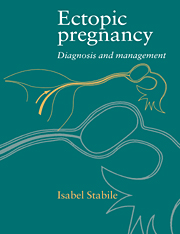Book contents
- Frontmatter
- Contents
- 1 Incidence, aetiology and pathophysiology of ectopic pregnancy
- 2 Clinical presentation of ectopic pregnancy
- 3 Biochemical diagnosis of ectopic pregnancy
- 4 Ultrasound diagnosis of ectopic pregnancy
- 5 Surgical diagnosis
- 6 Practical management of suspected ectopic pregnancy
- 7 Extratubal and unusual ectopic pregnancies
- 8 Medical treatment of ectopic pregnancy
- 9 Conservative and expectant management of ectopic pregnancy
- 10 Radical surgery
- 11 Pregnancy after ectopic pregnancy
- Epilogue: the future
- Index
9 - Conservative and expectant management of ectopic pregnancy
Published online by Cambridge University Press: 26 March 2010
- Frontmatter
- Contents
- 1 Incidence, aetiology and pathophysiology of ectopic pregnancy
- 2 Clinical presentation of ectopic pregnancy
- 3 Biochemical diagnosis of ectopic pregnancy
- 4 Ultrasound diagnosis of ectopic pregnancy
- 5 Surgical diagnosis
- 6 Practical management of suspected ectopic pregnancy
- 7 Extratubal and unusual ectopic pregnancies
- 8 Medical treatment of ectopic pregnancy
- 9 Conservative and expectant management of ectopic pregnancy
- 10 Radical surgery
- 11 Pregnancy after ectopic pregnancy
- Epilogue: the future
- Index
Summary
Introduction
In spite of the increased incidence of ectopic pregnancy in recent years the case fatality rate continues to fall. This may result from the widespread introduction of diagnostic tests and an increasing awareness by patients and their doctors of the serious nature of this disease. Consequently, the rate of tubal rupture (and hence dramatic presentation with life-threatening symptoms and signs) has become as low as 20% (Pansky et al.y 1991). Whether this trend will be seen in other parts of the world remains uncertain. What is clear is the increasing need for conservative and/or expectant forms of management to deal with that large group of women who present early with subacute ectopic pregnancy, i.e. our patients in group 3 (Balasch and Barri, 1994). For the purposes of this chapter, expectant management is defined as non-medical and non-surgical management and conservative treatment is any surgical operation in which the tube is conserved. Except where specifically stated, the management of a first ectopic pregnancy is discussed.
The choices
The treatment of ectopic pregnancy entails numerous choices by the physician: (i) whether to attempt it (expectant versus surgical or medical treatment); (ii) choice of route (laparoscopy, laparotomy, sonographic or transcervical); (iii) choice of operation (conservative versus radical); and (iv) choice of surgical approach (standard techniques versus microsurgery). The ideal management in an individual case depends on a number of variables, the principal ones being the location and size of the ectopic pregnancy and whether the tube has ruptured (Figure 9.1).
- Type
- Chapter
- Information
- Ectopic PregnancyDiagnosis and Management, pp. 111 - 131Publisher: Cambridge University PressPrint publication year: 1996



